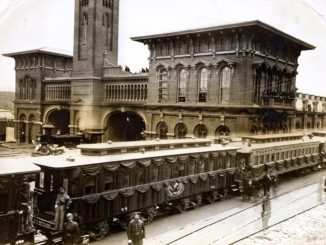
This weekend marks the anniversary of the departure of Lincoln’s Funeral Train from Washington, D.C. The Lincoln Funeral Train was a train that transported the body of President Abraham Lincoln from Washington, D.C. to his final resting place in Springfield, Illinois after his assassination in April 1865. The train journey, which lasted nearly two weeks and covered over 1,600 miles, was one of the most elaborate and well-attended funerals in American history.

The train was made up of nine cars and was led by the “United States,” a special funeral car built specifically for the occasion. The car was adorned with black crepe and had a catafalque, or a raised platform, on which Lincoln’s casket was placed. The casket was made of black walnut and had a glass top, allowing mourners to view the president’s body as it lay in state. The car also had a small room for Lincoln’s family and a larger room for dignitaries and government officials.
The train journey began on April 21, 1865, in Washington, D.C., where Lincoln’s body lay in state in the Capitol Rotunda for three days. Thousands of people came to pay their respects to the late president, including many who had served under him during the Civil War. From Washington, the train made stops in Baltimore, Harrisburg, Philadelphia, and New York City, where Lincoln’s body was displayed in various public buildings for people to view.
As the train made its way west, it was met by large crowds of mourners at every stop. In many towns, the train was met by a parade of soldiers and citizens, who would accompany the casket to the local depot. At each stop, the casket would be removed from the train and placed on a hearse, which would be drawn by horses through the streets to a designated viewing location. The casket would then be returned to the train for the next leg of the journey.
The train also made stops in Cleveland, Columbus, Indianapolis, and Chicago, where Lincoln’s body was displayed in the city’s main public buildings. In Chicago, a crowd of over 100,000 people came to view the president’s body, which was displayed in the Cook County Courthouse. The train also made stops in several smaller towns along the way, including Lincoln’s hometown of Springfield, Illinois.
The train arrived in Springfield on May 3, 1865, where Lincoln’s body was taken to Oak Ridge Cemetery for burial. The funeral procession was led by a detachment of soldiers and was followed by a large crowd of mourners. Lincoln’s body was placed in a temporary vault and was later moved to a permanent tomb in 1871.
The Lincoln Funeral Train was a significant event in American history, as it marked the end of the Civil War and the beginning of the healing process for a divided nation. The train journey brought together people from all walks of life, who came together to pay their respects to the fallen president. The funeral train also served as a symbol of national unity and a reminder of the sacrifices made by Lincoln and his fellow soldiers during the Civil War.


Be the first to comment